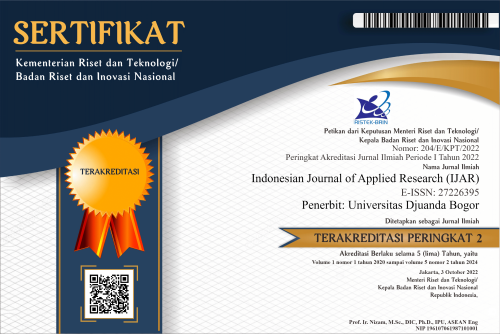In Silico, to Determine The Active Compounds of Black Tea and Turmeric In Increasing The Activity of The Enzyme Sod
Abstract
Damage to cells caused by stress can be reduced by the presence of antioxidants, one of which is Superoxide dismutase (SOD). The role of the active ingredients of black tea and turmeric will be studied using the in-silico method to identify the active compounds as components in SOD activation. The bioavailability and toxicity of the active compounds of black tea and turmeric were studied and followed by molecular docking and virtual games. The parameters studied are Gibbs's free energy (∆G) and binding site similarity (BSS). The results were analyzed using Gibbs's free energy (∆G) and binding site similarity (BSS) parameters. It was found that those that could increase the activity of Cu/Zn SOD enzymes were Epicatechin gallate (black tea) and curcumin (turmeric), with values of -9.5 and -7.4 Kcal/mol and the same BSS value of 81.8%. The control ligand used was beta amyrin. According to Lipinski's rules, Epicatechin gallate and curcumin compounds can be absorbed well and are safe for consumption. This study concludes that Epicatechin gallate, an active compound of black tea, and curcumin, an active compound of turmeric rhizome, have the best potential to increase the activity of Cu/Zn SOD enzymes based on the results of virtual screening and molecular docking. Epicatechin gallate and curcumin are predicted to be well absorbed by the body because they qualify Lipinski's rules and are not toxic and safe for consumption.
References
Anitha, P., Lavanya, P., Anbarasu, A., & Ramaiah, S. (2014). Molecular docking Study of catechins compounds from Camellia Sinensis against upps in Staphylococcus aureus. International Journal for Computational Biology, 3(2), 3–9. https://doi.org/10.34040/ijcb.3.2.2014.25
Ardhie, A. M. (2011). Radikal bebas dan peran antioksidan dalam mencegah penuaan. Medicinus, 24(1), 4–9. https://doi.org/10.1016/j.cger.2004.03.001
Awaluddin, R., Muhtadi, W. K., Chabib, L., Ikawati, Z., Martien, R., & Ismail, H. (2017). Molecular docking and ADME-toxicity studies of potential compounds of medicinal plants grown in Indonesia as an anti-rheumatoid arthritis. AIP Conference Proceedings, 1823, 1–9. https://doi.org/10.1063/1.4978106
Balaji, S., & Chempakam, B. (2009). Pharmacokinetics prediction and drugability assessment of diphenylheptanoids from turmeric (Curcuma longa L). Medicinal Chemistry, 5(2), 130–138. https://doi.org/10.2174/157340609787582873
Bhandari, K., Singla, R. K., De, B., Ghosh, B. C., Katakam, P., Khushwaha, D. K., Gundamaraju, R., Sen, G., Saha, G., Mitra, A., & Mitra, A. (2015). Chemometrics based extraction of polyphenolics from fresh tea leaves and processed tea showing in- silico docking and antioxidative theronostic dietary adjuvant in alzheimer. Indo Global Journal of Pharmaceutical Sciences, 05(03), 171–191. https://doi.org/10.35652/igjps.2015.02
Chagas, C. M., Moss, S., & Alisaraie, L. (2018). Drug metabolites and their effects on the development of adverse reactions: Revisiting Lipinski’s Rule of Five. International Journal of Pharmaceutics, 549, 133–149. https://doi.org/10.1016/j.ijpharm.2018.07.046
Chairunnisa, A., & Runadi, D. (2016). Aktivitas kalkon terhadap reseptor estrogen ß (ERß) sebagai antikanker payudara secara in vitro dan in silico: review. Farmaka, 14(2), 1–15.
Cogliano, V. J., Baan, R., Straif, K., Grosse, Y., Lauby-Secretan, B., Ghissassi, F. El, Bouvard, V., Benbrahim-Tallaa, L., Guha, N., Freeman, C., Galichet, L., & Wild, C. P. (2011). Preventable exposures associated with human cancers. Journal of the National Cancer Institute, 103(24), 1827–1839. https://doi.org/10.1093/jnci/djr483
Cosconati, S., Forli, S., Perryman, A. L., Harris, R., Goodsell, D. S., & Olson, A. J. (2010). Virtual screening with AutoDock: Theory and practice. Expert Opinion on Drug Discovery, 5(6), 597–607. https://doi.org/10.1517/17460441.2010.484460
Dongare, N., Walunj, Y., & Kulkarni, P. (2019). Theoretical validation of medicinal properties of Curcuma longa Linn - Part-2. Current Pharma Research, 9(2), 2752–2758. https://doi.org/11.258369/jcpr-324
Fatmawaty, Hanafi, M., Rosmalena, & Prasaty, V. D. (2015). Skrining in silico potensi senyawa allicin dari Allium sativum sebagai antiplasmodium. Jurnal Kimia Terapan Indonesia, 17(2), 175–184.
Ferdian, P. R., Elfirta, R. R., Emilia, Q., & Ikhwani, A. Z. N. (2021). Inhibitory potential of black seed (Nigella sativa l.) bioactive compounds towards main protease of SARS-CoV-2 : in silico study. Annales Bogorienses, 24(2), 81–94. https://doi.org/10.14203/ann.bogor.2020.v24.n2.81-94
Firdayani, Kusumaningrum, S., & Miranti, Y. R. (2017). Potensi senyawa bioaktif tanaman genus Phyllathus sebagai inhibitor replikasi virus hepatitis B. Jurnal Bioteknologi & Biosains Indonesia (JBBI), 4(2), 85–95. https://doi.org/10.29122/jbbi.v4i2.2589
Fu, B., Zeng, Q., Zhang, Z., Qian, M., Chen, J., Dong, W., & Li, M. (2019). Epicatechin gallate protects HBMVECs from ischemia/reperfusion injury through ameliorating apoptosis and autophagy and promoting neovascularization. Oxidative Medicine and Cellular Longevity, 3, 1–11. https://doi.org/10.1155/2019/7824684
Guan, L., Yang, H., Cai, Y., Sun, L., Di, P., Li, W., Liu, G., & Tang, Y. (2019). ADMET-score-a comprehensive scoring function for evaluation of chemical drug-likeness. MedChemComm, 10(1), 148–157. https://doi.org/10.1039/C8MD00472B
Hajiaghaalipour, F., Sanusi, J., & Kanthimathi, M. S. (2016). Temperature and time of steeping affect the antioxidant properties of white, green, and black tea infusions. Journal of Food Science, 81(1), 246–254. https://doi.org/10.1111/1750-3841.13149
Hatai, B., & Banerjee, S. K. (2019). Molecular docking interaction between superoxide dismutase ( receptor ) and phytochemicals ( ligand ) from Heliotropium indicum Linn for detection of potential phytoconstituents : New drug design for releasing oxidative stress condition / inflammation of . Journal of Pharmacognosy and Phytochemistry, 8(2), 1700–1706.
Ho, B. K., & Brasseur, R. (2005). The Ramachandran plots of glycine and pre-proline. BMC Structural Biology, 5(14), 1–11. https://doi.org/10.1186/1472-6807-5-14
Husain, N., & Kumar, A. (2012). Reactive oxygen species and cancer. Oxidative Stress: Eustress and Distress, 3(4), 164–175. https://doi.org/10.1016/B978-0-12-818606-0.00030-4
Ighodaro, O. M., & Akinloye, O. A. (2018). First line defence antioxidants-superoxide dismutase (SOD), catalase (CAT) and glutathione peroxidase (GPX): Their fundamental role in the entire antioxidant defence grid. Alexandria Journal of Medicine, 54(4), 287–293. https://doi.org/10.1016/j.ajme.2017.09.001
Ikpeama, A., Onwuka, G. I., & Nwankwo, C. (2014). Nutritional composition of tumeric (Curcuma longa) and its antimicrobial properties. International Journal of Scientific & Engineering Research, 5(10), 1085–1089.
Kanbarkar, N., & Mishra, S. (2021). Matrix metalloproteinase inhibitors identified from Camellia sinensis for COVID-19 prophylaxis: an in silico approach. Advances in Traditional Medicine, 21(1), 173–188. https://doi.org/10.1007/s13596-020-00508-9
Kodjio, N., Atsafack, S., Njateng, G., Sokoudjou, J., Kuiate, J.-R., & Gatsing, D. (2016). Antioxidant effect of aqueous extract of Curcuma longa rhizomes (Zingiberaceae) in the typhoid fever induced in wistar rats model. Journal of Advances in Medical and Pharmaceutical Sciences, 7(3), 1–13. https://doi.org/10.9734/jamps/2016/24949
Kumar, A., Prakash, A., & Dogra, S. (2011). Protective effect of curcumin (Curcuma longa) against d-galactose-induced senescence in mice. Journal of Asian Natural Products Research, 13(1), 42–55. https://doi.org/10.1080/10286020.2010.544253
Lamothe, S. M., Guo, J., Li, W., Yang, T., & Zhang, S. (2016). The Human Ether-a-go-go-related Gene (hERG) potassium channel represents an unusual target for protease-mediated damage. Journal of Biological Chemistry, 291(39), 20387–20401. https://doi.org/10.1074/jbc.M116.743138
Li, Y. M., Chan, H. Y. E., Huang, Y., & Chen, Z. Y. (2007). Green tea catechins upregulate Superoxide dismutase and catalase in fruit flies. Molecular Nutrition and Food Research, 51(5), 546–554. https://doi.org/10.1002/mnfr.200600238
Malau, N. D., & Sianturi, M. (2017). Analisa jembatan garam untuk meningkatkan kestabilan termal enzim xilanase Aspergilus niger. 1(2), 191–201.
Manogaran, E., Ramanathan, M., & Rao, T. R. (2015). Neuroprotective effect of curcumin against cholesterol induced neuroinflammation in In-Vitro and In-Vivo Models. Journal of Pharmaceutical Sciences and Research, 7(4), 189–196.
Martono, B., Falah, S., & Nurlaela, E. (2016). Aktivitas antioksidan teh varietas gmb 7 pada beberapa ketinggian tempat. Jurnal Tanaman Industri Dan Penyegar, 3(1), 53–60.
Motaghinejad, M., Motevalian, M., Fatima, S., Faraji, F., & Mozaffari, S. (2017). The neuroprotective effect of curcumin against nicotine-induced neurotoxicity is mediated by CREB–BDNF signaling pathway. Neurochemical Research, 42(10), 2921–2932. https://doi.org/10.1007/s11064-017-2323-8
Mulware, S. J. (2013). Trace elements and carcinogenicity: a subject in review. 3 Biotech, 3(2), 85–96. https://doi.org/10.1007/s13205-012-0072-6
Nirwana, A. C., & Mutakin. (2019). Aktivitas antioksidan dari suku Rutaceae. Farmaka, 17(1), 66–76.
Pratama, M. R. F. (2016). Studi docking molekular senyawa turunan kuinolin terhadap reseptor estrogen-α. Jurnal Surya Medika, 2(1), 1–7.
Rahman, M. F., Kasim, A., Djirimu, M. L., & Budiarsa, I. M. (2020). Analisis in-silico struktur tiga dimensi reseptor Trk A dan Trk B protein neurotrophin 3 pada gallus gallus (Chicken). Jurnal Biologi Papua, 12(2), 78–84. https://doi.org/10.31957/jbp.1059
Reshad, R. A. I., Alam, S., Raihan, H. B., Meem, Ka. N., Rahman, Fa., Zahid, F., Rafid, M. I., Rahman, S. M. O., & Ali, M. H. (2020). In silico investigations on curcuminoids from Curcuma longa as positive regulators of Wnt/β-catenin signaling pathway in wound healing. Orphanet Journal of Rare Diseases, 21(1), 1–9.
Rohdiana, D. (2015). Teh: Proses, karakteristik dan komponen fungsionalnya. Foodreview Indonesia, 10(8), 34–37.
Rohdiana, D., Arief, D. Z., & Budiman, A. (2013). Aktivitas penghambatan pertumbuhan bakteri Escherichia coli oleh berbagai jenis teh dan seduhannya. Jurnal Penelitiaan Teh Dan Kina, 16(1), 37–43.
Rollando, R. (2018). Pendekatan struktur aktivitas dan penambatan molekul senyawa 2-iminoethyl 2-(2-(1-hydroxypentan-2-yl) phenyl)acetate hasil isolasi fungi endofit genus fusarium sp pada enzim ß-ketoasil-ACP KasA sintase dan enzim asam mikolat siklopropana sintase. Pharmaceutical Journal of Indonesia, 3(2), 45–51. https://doi.org/10.21776/ub.pji.2017.003.02.2
Simanjuntak, P. (2012). Studi kimia dan farmakologi tanaman kunyit (Curcuma longa L) sebagai tumbuhan obat serbaguna. Agrium, 17(2), 103–108.
Suhadi, A., Rizarullah, & Feriyani. (2019). Simulasi docking senyawa aktif daun binahong sebagai inhibitor enzim aldose reduktase. Sel Jurnal Penelitian Kesehatan, 6(2), 55–65. https://doi.org/10.22435/sel.v6i2.1651
Sun, S., Pan, S., Ling, C., Miao, A., Pang, S., Lai, Z., Chen, D., & Zhao, C. (2012). Free radical scavenging abilities in vitro and antioxidant activities in vivo of black tea and its main polyphenols. Journal of Medicinal Plants Research, 6(1), 114–121. https://doi.org/10.5897/jmpr11.1308
Sunil, C., Irudayaraj, S. S., Duraipandiyan, V., Al-Dhabi, N. A., Agastian, P., & Ignacimuthu, S. (2014). Antioxidant and free radical scavenging effects of β-amyrin isolated from S. cochinchinensis Moore. leaves. Industrial Crops and Products, 61, 510–516. https://doi.org/10.1016/j.indcrop.2014.07.005
Suprihatin, T., Rahayu, S., Rifa, M., & Widyarti, S. (2020). Senyawa pada serbuk rimpang kunyit (Curcuma longa L.) yang berpotensi sebagai antioksidan. Jurnal Anatomi Dan Fisiologi, 5(1), 35–42.
Suryawanshi, S., & Kulkarni, P. (2020). Theoretical validation of medicinal properties of curcuma longa linn. Rasayan Journal of Chemistry, 13(1), 245–248. https://doi.org/10.31788/RJC.2020.1315581
Syahputra, G. (2015). Peran bioinformatika dalam desain kandidat molekul obat. Biotrends, 6(1), 26–27. http://terbitan.biotek.lipi.go.id/index.php/biotrends/article/view/10
Tanvir, E. M., Hossen, M. S., Hossain, M. F., Afroz, R., Gan, S. H., Khalil, M. I., & Karim, N. (2017). Antioxidant properties of popular turmeric (Curcuma longa) varieties from Bangladesh. Journal of Food Quality, 1–8. https://doi.org/10.1155/2017/8471785
Widiati, S. (2011). Daya hambat ekstrak ampas teh hitam (Camellia sinensis L.) terhadap pertumbuhan Staphylococcus epiderdimis. Universitas Atmajaya Yogyakarta.
Copyright (c) 2022 Indonesian Journal of Applied Research (IJAR)

This work is licensed under a Creative Commons Attribution-ShareAlike 4.0 International License.
The Authors submitting a manuscript do so on the understanding that if accepted for publication, copyright publishing of the article shall be assigned/transferred to Indonesian Journal of Applied Research (IJAR) Universitas Djuanda as Publisher of the journal. Upon acceptance of an article, authors will be asked to complete a 'Copyright Transfer Agreement'. An e-mail will be sent to the corresponding author confirming receipt of the manuscript together with a 'Copyright Transfer Agreement' form by online version of this agreement.
Indonesian Journal of Applied Research (IJAR) Universitas Djuanda, the Editors and the Editorial Board make every effort to ensure that no wrong or misleading data, opinions or statements be published in the journal. In any way, the contents of the articles and advertisements published in the Indonesian Journal of Applied Research (IJAR) Universitas Djuanda are sole and exclusive responsibility of their respective authors and advertisers.
Remember, even though we ask for a transfer of copyright, our journal authors retain (or are granted back) significant scholarly rights as mention before.
The Copyright Transfer Agreement (CTA) Form can be downloaded here: Copyright Transfer Agreement-IJAR 2020
The copyright form should be signed electronically and send to the Editorial Office e-mail below:
Prof. Dr. Ir. Dede Kardaya, M.Si. (Editor-in-Chief)
Universitas Djuanda
Jl. Tol Jagorawi No.1, Ciawi, Kec. Ciawi, Bogor, Jawa Barat 16720
Website: http://journal.unida.ac.id/index.php/IJAR/index
Email: ijar@unida.ac.id







 This work is licensed under a
This work is licensed under a 